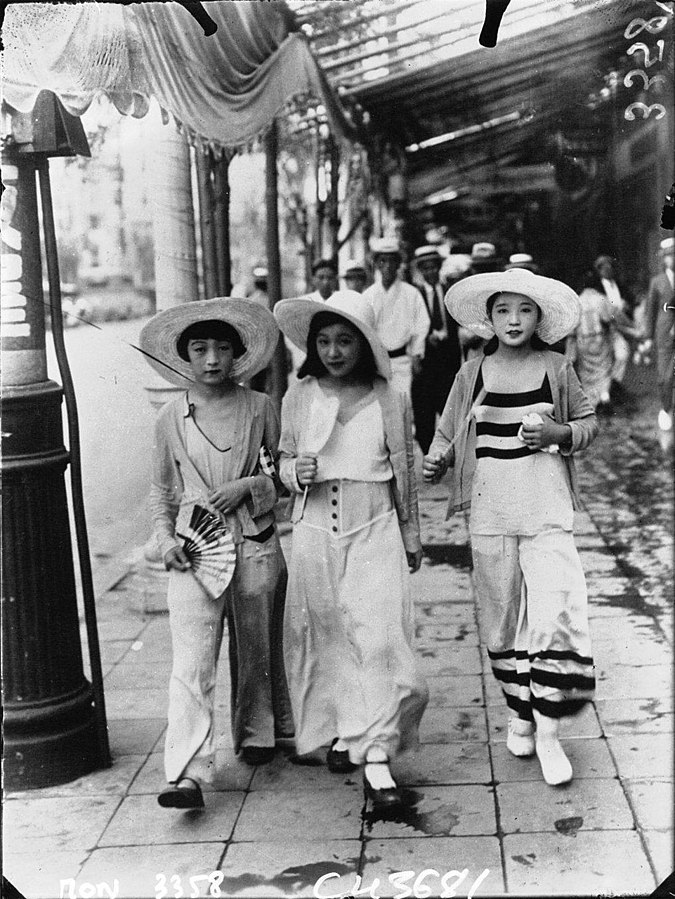
A photo of a modern woman of the Taisho period (19121927), Japan
With the influx of clothing in the Meiji era (1868-1912), kimono gradually became an outfit worn on special occasions such as weddings, funerals, and other special occasions. 02. The period from the Taisho era to the early Showa era saw the introduction of Western culture in various forms including the introduction of chemical.

These retroinspired kimono are a throwback to the large bold prints
61 Pins 40w T Collection by Tamar Heller Photos of Women in Western Garb 24 Pins Photos of Taisho Era Kimonos 3 Pins Photos of Women in Both Western Garb and Kimonos 4 Pins Taisho Era Kimonos and Haori Jackets 11 Pins Illustrations of Taisho Fashion (see my board on Art Nouveau and Deco Japan) 19 Pins Similar ideas popular now Taisho Era Japan

Taisho Period (19121926) History, Culture and Architecture Japan
While the anime takes place in the Taisho era, about when Western-style fashion became vogue in cities, the origins of Western and syncretic fashion in Japan can be found in the preceding Meiji.

Exclusive Japanese Fashion Style Midi Dress Taishō Period Women Chic
In the latter part of the Edo era, the government banned people from wearing ostentatious kimonos, so people adopted kimonos with plain patterns like stripes and chequered patterns. During the Meiji and Taisho era (mid-1800s to 1920s), the arrival of Western culture changed many aspects of Japanese society, including fashion.

Overcoat (Tonbi), Taishō period (191226) to Shōwa period (192689
What is the Taisho Era? The Taisho era (1912-1926) was a relatively short period of Japanese history nestled between the much longer Meiji (1868-1912) and Showa (1926-1989) eras. It was a time of great change, in which Western culture permeated Japanese popular culture and the average lifestyle of Japanese people changed drastically.

Pin on china
Taisho Era| History, Culture, and Art of This Period By Janbox - 05/05/2022 3222 Japanese culture since ancient times has brought many unique and distinctive features.

Pin on Recent Projects
The Taisho period is a short period in Japanese history between 1912 to 1926. It was the years of democratic movements across the political, economic and cultural fields. Many dramatic changes had been made during this period which gave huge impacts also on Japanese lifestyle; it became westernized and people started to wear western clothes and.

kimono daisuki // Japanese fashion women, Japanese style
the Western clothing known as Yōfuku Japanese styles mix pop culture with avant-garde looks. They are led by ever-evolving and exhilarating subcultures like: Kimonos (ancient Japanese attire) Lolita (the Victorian-inspired cute clothing) Gyaru (glamorous and youthful clothing) Shibuya (styles from the famous Shibuya mall of Tokyo)

Kimono HIME scans taisho style Japanese outfits, Modern kimono
Taisho Era (1912-1926) As the Taisho empire continued, modern living thrived. The dawn of radio, magazines and cinema inspired fresh styles such as decorated collars and new patterns. The West and the East began to share trends and by the end of the 1920s favoring a glamorous slim line with vertical draping in gowns, robes and dresses.

Image result for taisho era fashion now Kimono Japan, Yukata Kimono
Download the Temu App and start saving more today! Unleash incredible deals and coupons. Discover unbeatable deals and discounts on the Temu App. Download Now & Save Big!

Japanese Style Fashion Maxi Skirt Taishō Period Style Green Pleated
During the Taisho period (1912-1926), wearing Western clothing continued to be a symbol of sophistication and an expression of modernity. It was in this period that working women such as bus conductors, nurses, and typists started wearing Western clothes in everyday life.

Male Kimono, Yukata Kimono, Japanese Costume, Japanese Kimono, Japanese
The uptake of yofuku (Western clothing) filtered down through the classes, however many women found the new fashions impractical for Japanese living and for decades to come it was still common for women to wear kimono, increasingly paired with contrasting accessories like hats, scarves, gloves, umbrellas and handbags. Taisho: 1912-1926

Taisho Roman Japanese history, Taisho era, Taisho period
Listen to the episode to find out!# Taisho Era (1912-1926) Image Source. While the Meiji Era bombarded the Japanese with momentous modernizations day after day, and the Edo Era represented the old traditions, the Taisho Era struck a nice balance between the two. Even though this era was short-lived, it made quite an impact.

Japanese Fashion Wa Lolita Retro Taishō Period Style High Etsy
Japanese clothing during the Meiji period A woodblock print by Yōshū Chikanobu showing Japanese women in Western-style clothes, hats, and shoes ( yōfuku)

Emperor Taisho the Order of the Garter Emperor Taishō Wikipedia
Emergence of Modan Gāru Following the city's reconstruction after the disastrous earthquake, young girls who were sensitive to Western-influenced trends, known as modan gāru, or moga for short, started to appear in the 1920s.Dressed in the cutting-edge Western clothes and hats with cropped hair (Figure 9), Anzō Yūko and Koizumi Makiko argue that they became the symbol of modern.

Wa Lolita Casual Japanese Taishō Period Arrow Patterned Slope Etsy
Taishō eraTaishō jidai [taiɕoː dʑidai] was a period in the history of Japan dating from 30 July 1912 to 25 December 1926, coinciding with the reign of Emperor Taishō [1] The new emperor was a sickly man, which prompted the shift in political power from the old oligarchic group of elder statesmen (or Imperial Diet of Japan.